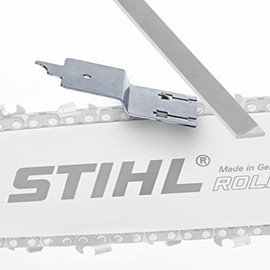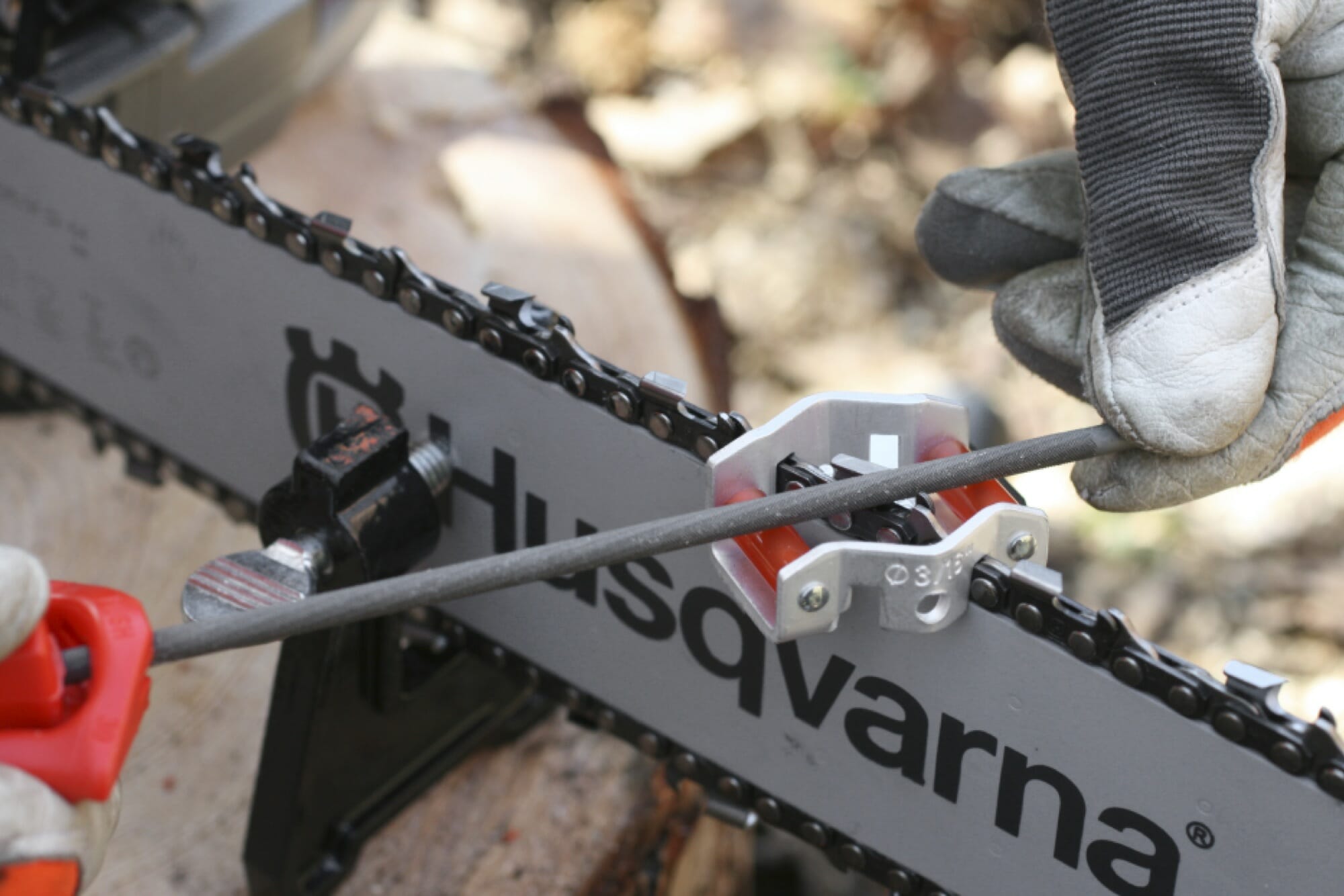You are using an out of date browser. It may not display this or other websites correctly.
You should upgrade or use an alternative browser.
You should upgrade or use an alternative browser.
Bar issue?
- Thread starter Treeaddict
- Start date
- Replies 48
- Views 5K
More options
Who Replied?Treeaddict
Treehouser
- Thread Starter Thread Starter
- #27
I made a jig where I could run my belt sander on its side. It has a small table in front of the belt. It may be perfect to bring the rails to the same length again.
When I had my workshop, I would just use the lanishing belt, but a normal file, with 2 sq wooden blocks either side of the bar will hold the file at 90 and is easily held with both hands when the bar is in a vice.
I also use the vallorbe/ stihl bar file tool, and it works well to give a smoother finish if you have already hit it with a sander.
I also use the vallorbe/ stihl bar file tool, and it works well to give a smoother finish if you have already hit it with a sander.
Trains, have you got a reference for " progressive raker guide"? thanks I've only seen the fixed gap Stihl units.
here is the stihl type.

File gauges - FL 1 to FL 5 file gauges: Manual sharpening for hardwood and softwood
For manual reworking of the depth gauge made from hardened steel with special coating. Two settings for hard and soft wood.
and the husky roller guide has one attached to it, I find they also work on some carlton chain and chinga copies.

Filing the chain - Husqvarna Chainsaw Academy
hope that helps.
So the benefit of the progressive raker guides, compared to the fixed gap type you mention, is that as the tooth gets filed back, and becomes narrower in width / kerf and shorter, it also becomes lower and further away from the raker, and thus, the raker needs to be lowered more than the fixed tool allows due to the distance between the tooth and the raker increasing.
the progressive guide takes care of that.
I used to use the fixed guide until I pooched a bunch of flat files on hardened rakers. Then I started benchmarking brand new chain with a flat bar tooth to tooth and altitude to the raker tip and it was larger then the fixed gap made. Then I figured the fixed tool left a crappy raker profile with no lead in ramp so I ended up doing Dremel Zen with a fiber reinforced cutoff wheel which is a pretty tiny grinder disc to form the ramp. Eyeball the altitude at the raker tip with flat bar.
How do you deal with hardened rakers killing files?
I found another progressive gizmo calibrated at .025, .030. .035 etc as opposed to hardwood softwood. I assume that refers to the fixed type altitude at the raker tip. (referred to the cutter highest point/tip).
What's up with porpoising chain? Does that seem real? Wouldn't that float the chain bar a bit?
How do you deal with hardened rakers killing files?
I found another progressive gizmo calibrated at .025, .030. .035 etc as opposed to hardwood softwood. I assume that refers to the fixed type altitude at the raker tip. (referred to the cutter highest point/tip).
What's up with porpoising chain? Does that seem real? Wouldn't that float the chain bar a bit?
Last edited:
Curious what chain you've had hardened rakers on. I've run into it twice on crappy Trilink chain. Never on Stihl, Oregon, or Carlton. I use a regular gauge, check the height, then file with the gauge off. Last stroke rounds off the leading edge.
edit:
When I say twice on the Trilink chain, that's 100% of the Trilink chains I've used. They came on saws I found in the trash. I'd never buy that junk unless I somehow had no good chains, had to get something cut, and that was all that was available.
edit:
When I say twice on the Trilink chain, that's 100% of the Trilink chains I've used. They came on saws I found in the trash. I'd never buy that junk unless I somehow had no good chains, had to get something cut, and that was all that was available.
Last edited:
SeanKroll
Treehouser
The guage I have had 4 settings, .025, .030, .035, and .040"
Magnus
TreeHouser
If the chain want to travel left or right in bar it will create wear, heat and drag.
Bars should not get wear on side of rail, chains drivelink side should not get any either.
The chain sould stay straight in the bar and rest/wear equally on Both tiestraps.
If not something is off, usually with uneven teeth from guage setting or sharpening.
This need correcting, if not you can replace as many bars and chains you like, it will be same result.
Sprocket/rim can cause damage to drivelink, drivling damage bar.
Replace this when replacing bar or sign of wear. It helps..
Rotating 10 chains per rim/bar do wonders as well.
If you replace chain you often run 4 chains/bar if not less..
Most runtime out of the $ win!
Bars should not get wear on side of rail, chains drivelink side should not get any either.
The chain sould stay straight in the bar and rest/wear equally on Both tiestraps.
If not something is off, usually with uneven teeth from guage setting or sharpening.
This need correcting, if not you can replace as many bars and chains you like, it will be same result.
Sprocket/rim can cause damage to drivelink, drivling damage bar.
Replace this when replacing bar or sign of wear. It helps..
Rotating 10 chains per rim/bar do wonders as well.
If you replace chain you often run 4 chains/bar if not less..
Most runtime out of the $ win!
SkwerI
Treehouser
I quit measuring rakers 30 years ago. I've always just counted the number of file passes on each tooth. Lay the flat file across the top of 2 teeth to eyeball the raker height. And you need to buy good hard raker files like Pferd.
Treeaddict
Treehouser
- Thread Starter Thread Starter
- #40
I don’t measure raker to tooth individually. Usually just go by feel. It seems like, on longer bars, it may not be the way to go. At least not at this point. Probably have to set the raker depth per tooth or at least per side.
I found that electronic level guy on -cough- Arb____ite and they totally nerded out there. My hardened rakers were Stihl chain, brand new Stihl files that died.
Anyone on the porpoising claimed in the Carlton chain booklet? I can see the cutting link tilting up from pure level during the cut because the tip gets pulled back a tad. But when you noodle wood seems like the cut is long and straight, no fish action (Pet Detective reference ) ?
) ?
Anyone on the porpoising claimed in the Carlton chain booklet? I can see the cutting link tilting up from pure level during the cut because the tip gets pulled back a tad. But when you noodle wood seems like the cut is long and straight, no fish action (Pet Detective reference
 ) ?
) ?stikine
Treehouser
The chain tooth does porpoise as it cuts otherwise you'd end up with chips the length of the log you are cutting. As the chisel bites the tooth rocks back on it's heel until the raker stops the bite and it rocks forward. Rinse and repeat over and over.
That looks more like the cutter link tilting in response to load/drag at the cutting tip. As to long chips - noodles are long, and in metal machining there's a science to making chips break off. Cross grain wood probably curls a bit and then gets broken, regardless of fish action. A video of a long bar in a long cut would be needed to show the cutter changing depth, in and out. IMO Interested to see it if possible.
stikine
Treehouser
Bart, crosscutting and ripping are very different and the dynamics of how the chain responds are very different because of the fiber characteristics of the wood in those two different scenarios.
Are you saying the grain determines whether there's porpoising? No mention of that in the Carlton booklet. ? The differences I've seen directly are raker depth, "hook" angle of the cutting edge and sharpness of the cutting edge causing everything from sawdust to simply digging in the chain and stalling the saw. I understand there's factors that affect the cutting but the porpoise eludes me. Closest analogy I have is chatter in a big drill bit in metal with a pilot hole or a conventionally sharpened drill bit stalling into brass. Maybe someone could stop mid porpoise cut and split the piece to show the porpoise trail on the cut surface. (?) I've always seen straight surfaces.
All in the name of curiosity
All in the name of curiosity

Depending on bar length, gauge, chain speed, tension, and overall sharpness, will affect how a chain performs, and how pronounced the wave (think frequency) that can happen in a chain.
Add to that the type of timber being cut, its grain structure, will also add to it.
So overall, yes, the chain will have waves in it for want of a better word, and some cutters will get a good bite, and create chips, and other parts of the chain may not get the same bite, but overall, if they dont bite, they help clear chips ready for the next tooth to bite.
Just keep your chain sharp, correctly tensioned, and then pay attention to being safe when cutting, not wondering what the chain is doing .
.
Add to that the type of timber being cut, its grain structure, will also add to it.
So overall, yes, the chain will have waves in it for want of a better word, and some cutters will get a good bite, and create chips, and other parts of the chain may not get the same bite, but overall, if they dont bite, they help clear chips ready for the next tooth to bite.
Just keep your chain sharp, correctly tensioned, and then pay attention to being safe when cutting, not wondering what the chain is doing
 .
.stikine
Treehouser
When noodling the chain teeth seem to have an extended period of fiber grab, thus the longer shavings. Crosscutting shortens the fiber grab cycle between rocking back and forth on the heel/raker as it cuts.Are you saying the grain determines whether there's porpoising?
I might have a high speed video footage to show...if I can find it.
Last edited:
Similar threads
Users who are viewing this thread
Total: 1 (members: 0, guests: 1)
